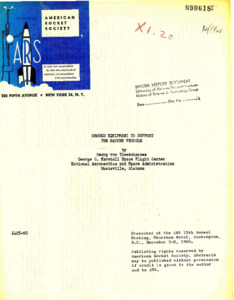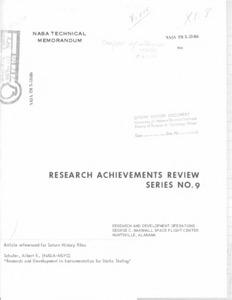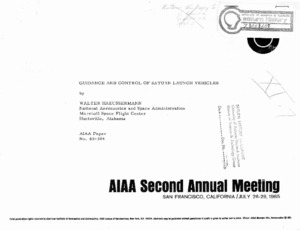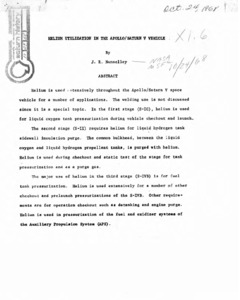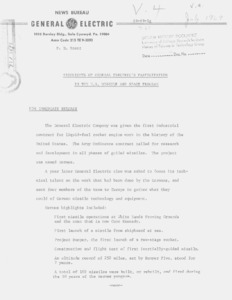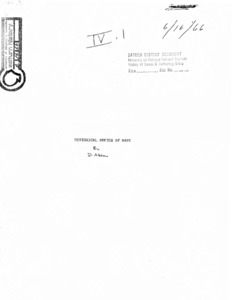
Browse Items (970 total)
Sort by:
-
"Ground Equipment to Support the Saturn Vehicle."
With the advent of the first large space vehicle, the SATURN, the ground support equipment and launch facility designer is faced with the necessity of conceiving and building an unprecedented launch system concurrent with the vehicle development. The paper intends to present a comprehensive picture of the problems involved and how they are solved. It follows the SATURN through the various modes of operation such as transportation over land and water, checkout, handling and erection, propellant loading, and describes the facilities at the launch site. -
"Ground testing at MSFC : research achievements review series no 9"
In 1955, the team which has become the Marshall Space Flight Center (MSFC) began to organize a research program within its various laboratories and offices. The purpose of the program was two-fold: first, to support existing development projects by research studies and second, to prepare future development projects by advancing the state of the art of rockets and space flight. Funding for this program came from the Army, Air Force, and Advanced Research Projects Agency. The effort during the first year was modest and involved relatively few tasks. The communication of results was, therefore, comparatively easy.; Pages of handwritten notes on yellow legal paper. There is also a 3 x 5 inch card with this information. Article reference for Saturn History Files: Schuler, Albert E. (NASA-MSFC) Research and development in instrumentation for static testing. -
"Guidance and Control of Saturn Launch Vehicles."
The navigation, guidance, and control modes and problems of the Saturn launch vehicles are given as the requirements for the guidance and control methods. Two path adaptive guidance modes, featuring flight path optimization, in the form of a polynomial mode and an iterative mode are given in their computation form and compared with respect to mission flexibility, implementation requirements, and performance. Attitude control during the propelled flight phases requires consideration of various bending and sloshing modes; stability of the control system is obtained by phase stabilization of the low frequencies and by attenuation of the higher frequencies. Typical shaping networks and their transfer functions are given. The attitude control system during coasting periods is briefly described. The functional behavior and characteristic data of the main guidance and control hardware such as the inertial sensors, stabilized platform, digital computer, data adapter, control computer, and actuation system are described. Reliability requirements are emphasized. The principle of redundancy is extensively used to obtain highest reliability for long operating times. Data and results from recent Saturn I flights summarize the performance of the guidance schemes. -
"H-1 rocket engine: models H-1C and H-1D : technical manual engine data."
Poor jpeg of a screenshot of a word-document. -
"Helium Utilization in the Apollo/Saturn V Vehicle."
Helium is used extensively throughout the Apollo/Saturn V space vehicle for a number of applications. The welding use is not discussed since it is a special topic. In the first stage (S-IC), helium is used for liquid oxygen tank pressurization during vehicle checkout and launch. -
"High Energy Missions for Saturn."
Presented to Society of Automotive Engineers, Advanced Launch Vehicle & Propulsion Systems. When the Apollo lunar landing project is complete, the Saturn and Apollo hardware will only have begun to realize their ultimate potential for space exploration. The immense reserve of Apollo technology, facilities, and booster capability can then be directed to the achievement of national goals which lie far beyond the initial lunar landing. In achieving the Apollo lunar objectives, large investments will have been made in launch facilities, tracking systems, propulsion techniques, reentry systems, lunar landing systems and rendezvous technologies. Although developnent in these specialized areas has been tailored to the needs of Apollo, numerous studies by NASA and industry have demonstrated the feasibility of using the spacecraft, launch vehicles, and operating techniques for missions far more complex than lunar landings. Amortization of this hardware will prove cost-effective for missions of more sophisticated applications. -
"Highlights of General Electric's Participation in the U.S. Missile and Space Program."
Press release covering the system of functional management in NASA. -
"Historical Notes on Oral History in NASA."
Prepared for the Second National Colloquium on Oral History, Columbia University. Contains notes on the oral history of NASA. -
"Historical Profile: North American Aviation, Inc."
Paper written as a study of functional management in NASA. -
"Historical Sketch of MSFC."
A rocket from the George C. Marshall Space Flight Center will carry the first American to the moon, and the deadline is 1970. Because of the Center's expanding role in space, there are increasing requests for information about our activities. This brief historical sketch should help to answer questions about our past, our present, and our hopes for the future. Marshall Space Flight Center (MSFC) is the largest installation of the National Aeronautics and Space Administration (NASA). The Marshall Center is NASA's agency responsible for large space rockets and related research. MSFC employs about 7500 civil service employees with an annual payroll of more than {dollar}82 million. In addition approximately 4300 contractor employees work for MSFC on the Arsenal, earning an estimated {dollar}43 million. The Center occupies about 1800 acres near Huntsville, Alabama; in this large area are 270 buildings with floor space totalling about 4,000,000 square feet for a real estate and property value of about {dollar}325 million. MSFC's 1966 fiscal year budget was {dollar}1.8 billion. Obviously MSFC has much human and monetary worth behind United States round trips to the moon and beyond. In addition to its size, MSFC is unique because it has a large rocket development team with more than three decades of experience. Prior to the rocket work that dates back to Peenemuende [sic] the world heard little and cared less concerning rockets and space. As a group Marshall has always thought big. It has worked together as a group, and equally well with fellow scientists throughout the Free World, to get the most into space soonest. This is why there is increasing interest in larger and larger rockets and rocket programs from our Center, a fact generating more and more questions about our Center, and in turn generating a "workload" request for this sketch by the Historical Office. We hope that you enjoy our historical sketch, which could as well be entitled "Closer and Closer Views of the Moon and Beyond." David S. Akens, MSFC Historian.
